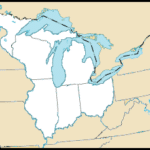
The American System was Henry Clay’s three-part economic plan for the United States in the early 19th century. American System APUSH questions will center on the purpose and components of the plan.
What is the American System?
In the early 1800s, prominent Kentucky statesman Henry Clay proposed the American System— a plan designed to strengthen the economy of the United States.
The American System had three parts:
- Tariffs: A tariff is a tax on imports. Clay argued that high tariffs would encourage Americans to buy domestic goods rather than foreign goods and promote the growth of American industries.
- National Bank: Clay wanted to reinstate a national bank after the First Bank of the United States’ charter had expired in 1811. He believed a national bank would stabilize currency, promote trade, and limit the influence of riskier local banks.
- Infrastructure: Clay wanted to improve and expand upon the nation’s transportation network, making commercial transport much easier. He proposed paying for these improvements with revenues collected from the tariffs.
Parts of the American System were implemented by Congress. Tariffs remained high for much of the first half of the century. The Second Bank of the United States was chartered in 1816. Some infrastructure improvements were made, but not to the extent that Clay had hoped. Congress failed to approve adequate funding for the projects. Overall, however, Clay was proud of the plan and deemed it successful.
Important year to note for the American System:
1816: Second Bank of the United States formed
Why is the American System so important?
The American System shaped national economic policy in the first half of the 19th century. It helped the young nation to grow in strength.
Domestically, the American System was met with mixed reactions from the public. While many lauded it for bolstering growth, some were unhappy with its tenants. For example, the tariff was unpopular in the West and South, who felt that the tax unfairly favored the interests of northeastern manufacturers. This was part of a growing trend of sectionalism in the years leading up to the Civil War.
What are some historical people related to the American System?
- Henry Clay: Kentucky statesman who proposed the American System; at various points, Clay served as a Senator, Speaker of the House, and Secretary of State
- Alexander Hamilton: former Secretary of the Treasury; Clay drew inspiration from many of Hamilton’s economic ideas, especially the national bank, when crafting the American System
What example question about the American System might come up on the APUSH exam?

“The Monkey System, or ‘Everyone for himself at the expense of his neighbor!’” by E.W. Clay, 1831. (Source)
The group most likely to oppose Henry Clay’s American System was
A) northeastern merchants.
B) southern cotton planters.
C) western manufacturers.
D) Republicans nationwide.
Answer:
The correct answer is (B). Southern cotton planters opposed the high tariffs of the American System. They claimed that the tariff unfairly favored the interests of northern manufacturers. Clay’s counterargument was that the South should support the North’s growth because the North provided a market for their cotton. This argument was weak, however, since southern planters had plenty of foreign markets for their cotton.





